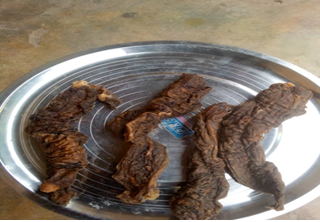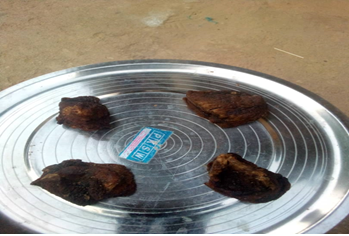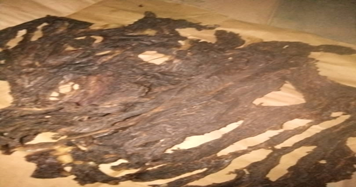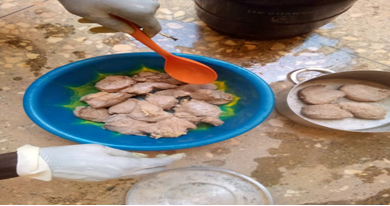Documentation and Quality Evaluation of Disappearing Ethnic Heritage Meat Products in Kebbi State, Nigeria
- Mohammed Ibrahim Ribah
- Muhammad Kabiru Bahago
- Muáwiya Jibir
- 169-185
- Dec 22, 2023
- Microbiology
Documentation and Quality Evaluation of Disappearing Ethnic Heritage Meat Products in Kebbi State, Nigeria
Mohammed Ibrahim Ribah1*, Muhammad Kabiru Bahago1 and Muáwiya Jibir2
1Department of Animal Science, Faculty of Agriculture, Kebbi State University of Science and Technology, Aliero, PMB 1144 Birnin kebbi, Nigeria
2Department of Animal Science, Faculty of Agriculture, Usmanu Danfodiyo University Sokoto, PMB 2346, Sokoto, Nigeria
*Corresponding Author
DOI: https://doi.org/10.51584/IJRIAS.2023.81115
Received: 17 November 2023; Accepted: 28 November 2023; Published: 22 December 2023
ABSTRACT
Disappearing meat products (DMPs) are heritage/ethnic meats products that have disappeared or at the risk of disappearing. Different ethnic groups have their peculiar cuisines especially meat products. This two phase study was conducted to assess disappearing heritage meat products in Kebbi State, document their production process and evaluate their nutritive value. A snowball expert sampling was used to interview 60 respondents of advanced age across the major ethnic groups of the state. Results revealed sixteen (16) DMPs identified in the state. Yàwárá, Gàdéé, Karmami and Dánbutáári DMPs were identified and ranked first each from Zuru, Gwandu, Argungu and Yauri, respectively. Proximate Composition and pH of fresh DMPs indicated significant differences (P<0.05) in respect to moisture content, Ash, protein, Nitrogen, and CHO of DMPs and also shows no statistical differences (P>0.05) on Lipid and pH for fresh products among the products. Similarly, all proximate components were significantly affected (P<0.05 after storage. pH was not significantly affected (P<0.05) by storage. Results of Sensory properties indicated significant differences (P<0.05) on juiciness and flavor while aroma and tenderness were not significantly affected (P>0.05). Danbutari, gade, yawara and karmami were ranked 1st, 2nd, 3rd and 4th, respectively. T-test of proximate composition of DMPs before and after storage showed that storage had significantly affected (P<0.01) total protein, total carbohydrate contents and total pH of fresh and stored DMPs with total P-values of 9.30E-05, 1.70E-06, and 0.046, respectively. It was concluded that all the products exhibited good sensory qualities of tenderness, juiciness, flavor and aroma having scored between 5.5 and 8.7 on a 9 point hedonic scale and Karmami product performed better among the dried DMPs ranking 1st in optimizing proximate and eating qualities.
Keywords: Quality Evaluation, Disappearing, Ethnic, Heritage, Meat Products
INTRODUCTION
Cultural heritage is the heritage of tangible and intangible assets of a group or society that is inherited from past generations. According to [3], cultural heritage preservation provides economic gains, protects local and national identity and pride, and reminds people of their common history and progress. Cultural heritage contribute to a society’s social, economic and environmental goals. Not only does cultural heritage enable sustainable development in terms of economic growth, such as increased tourism and local jobs, it also enhances the inhabitants’ sense of identity and a feeling of connection. Ethnic meats products are part of the identity of a local culture, are always popular locally, have evolved over centuries and are passed over from generation to generation [4]. Traditional meat products are high sensory quality heritage foods, usually with high nutritional value, produced on a small scale, using ingredients and procedures from ancient times [5] and [6]. Consumer demand for local food, including local meat and poultry, has risen in recent years [7].
All over the world, different processes are used to preserve meat and the traditional knowledge of people living in different regions gave rise to a great diversity of meat products according to their traditions and historic use [5]. These traditional processes, their particularities, and their effect on the quality and safety of meat products are important research topics. However, lesser efforts are being laid to convert this actual knowledge to engaging knowledge. In Nigeria, the disappearance of traditional foods, especially meat products is grossly understudied as little or no documented records are available. Rapid urbanization and industrialization is increasing the demand for meat products, hence, a lot of efforts need to be made to enhance the standardization of traditional heritage meats to meet the demand. Processing, quality characteristics, present consumption of traditional meat products is therefore necessary to be studied, developed and implemented.
Several notes of concerns have been raised by authors, bloggers and people in the food industry on how heritage foods and meat products are alarmingly disappearing. Notable among the concerns was the one raised by [8] who reported that culture and food habits that have been taken away by a society may suddenly disappear, or, may be eroded as a result of deliberate policies by a more ruthless power, or by the subtle pressure of other social values like religion and civilization, which are believed to be superior. It was opined by [2] that an in-depth study of different indigenous meat products and their special attributes may be very useful in the development of meat industry, wherein meat based fast foods are gaining importance in all over. The documentation of traditional meat products is little or lacking till recent times. Even though oral elucidation by the native people exists, the documentation was in its naive phase, keeping this traditional knowledge far from light. Hence, this research is designed to attempt documenting disappearing meat products in Kebbi State with the aim of identifying and describing their processing methods; and evaluation of their quality. Documentation of these products not only save these rare culinary skills of tribal people but also provide a market value for them as well as educational, research and preservation of cultural heritage.
MATERIALS AND METHODS
A. Study Area
The study covered the entire Kebbi State. According to Kebbi State Government report (2018) Kebbi State is located on the north western part of Nigeria between latitudes 100 and 130N and longitudes 30’ and 60E. The mean annual rainfall in the state varies significantly from the northern part (733mm) to the southern area (1045mm). Kebbi State comprises of 21 Local Government Areas. Like all other State in the country, Kebbi State has diverse ethnic composition including Hausa/ Fulani, Dakarkari (Lalna), Fakawa, Dukawa, Kambari, Gungawa, Zabarmawa and many other minority ethnic groups having diverse culture and values. The state is blessed with tremendous livestock resources and potentials for meat/milk production, and draught-oxen for farm traction. Every household, in almost all the communities across the state, keeps one form of animal or the other, as an economic investment or as pet.
B. Field Survey
A field Survey was conducted across the known ethnic groups of Kebbi state to collect data on disappearing meat products using scheduled visitations and interviews.
C. Sampling and Sample Size
Purposive sampling method was used to select the major ethnic groups from each of the four (4) Emirate Councils of the state. After identifying the ethnic groups to be used, expert and snowball sampling techniques was used to interview five (5) respondents from each ethnic group. The total respondents that were used for the study is 60 as indicated in Table 1.
Table 1. Sampling techniques and sample size
| Emirate councils | Ethnic groups | No. of Respondents |
| Gwandu | Hausa
Fulani Kabawa Zabarmawa |
5
5 5 5 |
| Argungu | Arawa
Kabawa |
5
5 |
| Zuru | Dakarkari
Dukkawa Fakkawa |
5
5 5 |
| Yauri | Kambari
Gungawa Hausawa |
5
5 5 |
| 4 | 12 | 60 |
D. Sample Preparation
The samples for the study were prepared according to the description by the expert respondents during field survey. Three (3 kg) of boneless beef were purchased for each product from Jega slaughter slab. The collection of the raw meat was done under optimum hygienic condition, using disposal hand gloves, clean polythene bags and clean containers. The meat for each product was divided in to twelve (12) samples containing 250g each. Ten (10) samples of each product were used for acceptability test, one (1) sample each for pH examination and one (1) sample each was used for proximate analysis.
E. Determination of Proximate Composition
The data collection for the proximate composition were obtained through proximate analysis, The manufactured samples of each product was bagged, label and stored in a -8°C freezer until analyzed for proximate composition and pH. Moisture, fat and protein were determine directly after storage using Infratech Analyzer (Model Tecator 1265, Sweden). Ash determination was carried out according to [10].
- Determination of moisture content
Moisture content were determined by using the air oven drying method by AOAC Official Method 990.19 [10]. The measurement was done by drying the samples in a Model 600 air oven (Memmert, Germany) at 105°C for overnight. The dish was then cooled in a desiccators and weighed the process will be repeated until constant weight reached
- Determination of protein content
Kjeldahl Method was used to determine protein content based on the standard procedure in AOAC Official Method 973.48 [10]. This method was performed based on an automated Kjeltec instrument (Foss, Germany) to determine protein content in meat products samples.
- Determination of fat content
Fat content were determined based on the Soxhlet extraction method by using AOAC Official Method 960.39 [10]. Instead, Fat content were measured by weight loss of the sample or by weight of the fat removed
- Determination of ash content
Ash content of the samples were determined using the dry ashing method AOAC Official Method 999.11 (AOAC 2016). Ashing of product sample (10 g) was done in a Thermo Scientific Thermolyne 62700 muffle furnace at 550°C. Before ashing, the crucible was dried in an oven at 105°C for 3 hrs.
- Determination of pH
pH values were measured using a Testo 205 pH meter (Testo AG, Lenzkirch, Germany) to obtain the ph of the products.
F. Determination of Sensory Qualities
A data for acceptability were obtained through panel of ten judges using a nine (9) point hedonic scale of intensity, to determine the eating quality and acceptability of the meat product identified. Panel of ten untrained judges was utilized for the acceptability of each product to express their like or dislike base on hedonic scale of intensity as described by Lawlor et al., (2012).
G. Data Collection
Data for the study was collected through structured questionnaire schedule to interview the respondents. The respondents used were individuals of advanced age groups who could be aware of some meat products that are disappearing or disappeared, and are willing to share the knowledge of the products. Audiovisual recordings were used to capture the respondents description of the products and the description of the process of producing the products. Data were collected on types of disappearing meat products, their morphology, methods of processing, significance of the products, storage, shelf life and acceptability of the products.
H. Data Analysis
The data from the survey are presented in a table containing the list of the identified meat products, description and manufacturing process according the way explained by the expert respondents.
RESULTS AND DISCUSSION
A. Types and Characteristics of Disappearing Meat Products Found in Kebbi State
The survey results for type ad characteristics of disappearing meat products (DMPs) in Kebbi State are shown in Table 1a, Table 1b and Table 1c. Result shows that a total of sixteen (16) DMPs were found in the study area including Yààwárá, Antawiya, Kagadsaa, Yakuwa and daudawameat, Karmami, Banda, Gade, Danbutari, Danbunnamamaizuma, Chikadondos, Dafuwarkaf, Kwatta, Tukudi, Gashinkasa, Soyentsinkamaikwai, and Soyemaizuma. From the respondents interviewed in Zuru, all mentioned Yawara (100%), antawiya (46.6%), kagdsaa (20%) and banda (13.3%). Similarly, respondents interviewed in Argungu mentioned Karmami (50%), gade (40%), banda (30%) and Naman yakuwa da daudawa (10%). In Yauri Emirate, respondents mentioned Danbutari (53.3%), Yààwárá (46.6%) followed by antawiya and dambun nama mai zuma with 20% each. Banda and Gàdéé scored 13.3% each. As for Gwandu Emirate, respondents mentioned gade (55%), dambun nama mai zuma scored 25% while Kwatta, Tukudi, Gashin kasa, Soyen tsinke mai kwai, and Soye mai zuma scored 5% each. Results shows that yawara, karmami, danbutari and Gàdéé were the most popular products in Zuru, Argungu, Yauri and Gwandu Emirates, respectively.
Table 1a. Types and characteristics of disappearing meat products found in Zuru and Argungu Emirates, Kebbi State
| S/N | Product type | Location | Morphology | Shelf life | Freq. | (%) | Rank |
| Zuru Emirate | |||||||
| 1 | Yààwárá | Zuru | Long sliced dry meat | 3-12 months | 15 | 100 | 1st |
| 2 | Antawiya | Zuru | dark red cooked blood | 24 hours | 7 | 46.6 | 2nd |
| 3 | Kagdsaa | Zuru | Semi dry meat for cooking | 7days | 3 | 20 | 3rd |
| 4 | Banda | Zuru | Tough dry meat cuts | 6 months | 2 | 13.3 | 4th |
| Argungu Emirate | |||||||
| 1 | Karmami | Argungu | Dried slice tin sheets of meat | 1 day | 5 | 50 | 1st |
| 2 | Gàdéé | Argungu | Dry lean cuts of meat | 1 month | 4 | 40 | 2nd |
| 3 | Banda | Argungu | Tough dry meat cuts | 6months | 3 | 30 | 3rd |
| 4 | Namanyakuwa da daudawa | Argungu | Soft very palatable cooked meat in a blend of fermented locust beans cake | 1 year | 1 | 10 | 4th |
Source: field survey, 2023.
Table 1b. Types and characteristics of disappearing meat products found in Yauri Emirate, Kebbi State
| S/N | Product type | Location | Morphology | Shelf life | Freq. | (%) | Rank |
| 1 | Dánbutáári | Yauri | Cooked sauce of lean meat | 1 day | 8 | 53.3 | 1st |
| 2 | Yààwárá | Yauri | Long sliced dry meat | 3-12 months | 7 | 46.6 | 2nd |
| 3 | Antawiya | Yauri | dark red cooked blood | 24 hours | 3 | 20 | 3rd |
| 4 | Danbun nama mai zuma | Yauri | Fried tiny particles of meat in honey liquid | 1 year | 3 | 20 | 4th |
| 5 | Banda | Yauri | Tough dry meat cuts | 6months | 2 | 13.3 | 5th |
| 6 | Gàdéé | Yauri | Dry lean cuts of meat | 1 month | 2 | 13.3 | 6th |
| 7 | Chikadondos | Yauri | Slightly fry cattle intestines | 3days | 1 | 6.6 | 7th |
| 8 | Dafuwarkaf | Yauri | Soft stirky cooked meat | 1 day | 1 | 6.6 | 8th |
Source: field survey, 2023
Table 1c. Types and characteristics of disappearing meat products found in Gwandu Emirate, Kebbi State
| S/N | Product type | Location | Morphology | Shelf life | Freq. | (%) | Rank |
| 1 | Gàdéé | Gwandu | Dry lean cuts of meat | 1 month | 11 | 55 | 1st |
| 2 | Danbunnamamaizuma | Gwandu | Fried tiny particles of meat in honey liquid | 1 year | 5 | 25 | 2nd |
| 3 | Soyemaizuma | Gwandu | Fry lean meat in honey liquid | 1 year | 3 | 15 | 3rd |
| 4 | Kwatta | Gwandu | Soft cooked hide of cattle | 1day | 1 | 5 | 4th |
| 5 | Tukudi | Gwandu | Squeezed tiny particles of fried meat | 1 month | 1 | 5 | 5th |
| 6 | Gashinkasa | Gwandu | Small cuts of meat in broom sticks marinated with spicy groundnut powder | 1 week | 1 | 5 | 6th |
| 7 | Soyentsinkemaikwai | Gwandu | Fry lean meat with egg | 3days | 1 | 5 | 7th |
Source: field survey, 2023
B. Manufacture Process of Popular Identified Disappearing Meat Products in Kebbi State
Results in Table 1a, 1b and 1c, indicated that from each Emirate of the state, there is a meat product that was more popular. Hence, Yààwárá, Gàdéé, Karmami and Dánbutáári were identified and ranked first each from Zuru, Gwandu, Argungu and Yauri, respectively. The popularity of such meat products signifies their importance even in their time among other products. Therefore, the processing of these four (4) major products, one from each Emirate were described giving their cultural names, morphology, shelflife and processing procedure.
Yààwárá meat product
The product was a popular product in Zuru and Yauri Emirates with its cultural names as Yààwárá (Hausa), S’àrèèè (dakarci), àyàwárá (kambari) and Às’áár (fakkanci). The product is a dried meat and has currently disappeared. It is a sliced dry strips of meat, dark red in colour. It is a dried meat product. The Processing of Yààwárá was reported to be produced from red lean meat of large animals whose meat cannot be consumed at once by a family. From the information gathered, the product can last for as long as twelve (12) months. The harmonized processing method for the product is described in the following steps:
STEP 1: Fresh meat can be obtained from beef, chevon, mutton, hippopotamus, crocodile etc.
STEP 2: Deboning the meat to remove all the bones from the meat obtained to enhance easy slicing
STEP 3: Washing with clean water to make the meat free from blood and other impurities
STEP 4: Slicing into strips into 30—45cm long, 4-5cm wide and 1.5 – 2.5cm thick to enhance easy drying of the meat.
STEP 5: Marinating of the cut strips of meat. This can be done by rubbing the meat with salt or guinea corn powder to facilitate drying and prevent flies and probably to militate pathogenic microorganism activities in the meat.
STEP 6: Arranging the meat strips in drying sticks. the strips of marinated meat is usually done by hanging the meat on stick bars constructed and placed in an open field for heat radiation and enough air circulation to facilitate drying process.
STEP 7: Drying in the sun which is achieved by using direct sunlight or under the shade depending on the prevailing weather condition, and desire of the processor. Drying may take between 2 – 3 days to dry if the weather condition is favorable. The moisture content of the meat is reduced to less than 5%, where water activity (aw) for the growth and multiplication of microorganisms will be hindered.
STEP 8: Smoking. The dried meat can be smoked for 2 – 3 days or kept in the local kitchen where it will be perceiving smoke for about 1 week or 2 weeks to give the meat a characteristic taste and ensure complete moisture content draining from the meat.
The production process is shown in Figure 1 below.
Fig. 1 Flow chart for Yààwárá meat product.
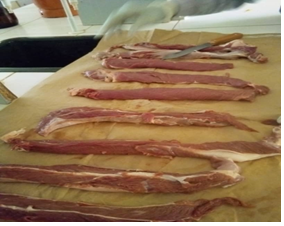
Plate 1: Fresh strips of lean beef meat Plate 2: Finished Yààwárá product
Gàdéé meat product
Gàdéé(Hausa – generic) is a dried meat product and was a popular meat product in Gwandu, Yauri and Argungu Emirates but currently disappeared. The product is a dried chunk cuts of lean boiled and smoked meat, with its dark red colouration. This product was reported to be produced from excess lean meat from large animals that could not survive some natural disaster such as disease outbreak or natural accidents or older animals that have low quality meat. The processing steps below were harmonized from various descriptions as follows:
STEP 1: Fresh meat can be obtained from beef, chevon, mutton, camel meat etc.
STEP 2: Deboning: All the bones will be remove using a sharp knife to enable easy processing.
STEP 3: Cutting with a sharp knife into sizeable cuts of about 200g per each.
STEP 4: Washing with clean water to get the meat out of blood and other particles of soil, weeds etc.
STEP 5: The meat will then be briefly boiled in hot water for about (10- 15minutes) until the colour changes.
STEP 6: After boiling, the meat will be removed from the hot water and adequately drained for about 30 – 40 minutes.
STEP 6: The drained boiled meat cuts will then be placed on wire mesh over a local grill and cover the meat with sheet of paper or leaves of trees. Fire will then be set to produce little fire with much smoke, this smoking will continue for 2 – 3 days until the moisture content is considerably reduced to 5 – 10%.
STEP 7: The smoked meat will then be spread in the sun on local mats to ensure further drying. When the meat dried up, it will then be bagged for storage or transportation.
Figure 2 below shows the processing flowchart of gadee meat product.
Fig. 2 Flow chart for Gàdéé meat product.
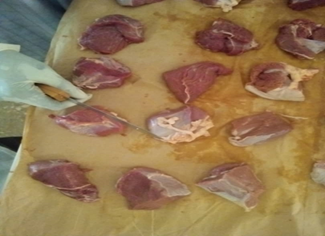
Plate 3: Fresh cuts of lean beef chunks Plate 4: Finished gadee product
Karmami meat product
This was a popular meat product in Argungu Emirate. It is a sliced dry thin sheets of lean meat obtained from low quality meat of old or sick animals. It was a peculiar. The harmonized steps in the processing of karmami meat product are as follows:
STEP 1: Fresh meat can be obtain from very low quality meat of Beef, chevon and mutton, STEP 2: Deboning using a sharp knife to enhance slicing.
STEP 3: washing with clean water to wash away the blood and other dirts.
STEP 4: The deboned meat will be sliced into thin sheets of about 2mm thick to facilitate complete drying of the product.
STEP 5: The sliced thin sheets of meat will then be spread on local corn straw beddings or mats available and sun dried. Depending on the weather conditions, it was gathered that complete drying can be achieve within 3 days.
STEP 6: After drying, the sheets of dried meat are then arranged in local silos for storage, and can store up to one year. The flowchart in figure 3 below shows the production steps of the product.
Fig. 3 Flow chart for karmami meat product.
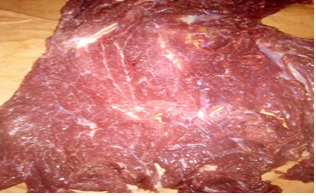
Plate 5: Fresh sliced lean beef Plate 6: Finished karmami product
Dánbutáári meat product
Dánbutáári (Hausa- generic) is a ready-to-eat sauced meat product that was popular in Yauri and Gwandu Emirates. It is a spicy sauce of soft cuts of lean meat obtained from low quality meat especially the connective tissues that are usually trimmed from lean meat. The harmonized steps in processing of Dánbutáári meat product are as follows:
STEP 1: Fresh meat can be obtained from lean small ruminant animal like sheep and goat which may be sick or extremely emaciated as a result of starvation or sickness.
STEP 2: The meat will be deboned and cut into sizeable pieces of about 30g.
STEP 3: The pieces of the meat will then be washed thoroughly with clean water to enhance proper cleaning of the impurities.
STEP 4: The washed cut meat pieces will now be cooked for about 1 or 2hours. spices like onion, pepper, ginger, garlic, salt and seasoning will be added at the initial time of cooking, toward the end time of cooking about 40minutes from starting groundnut cake powder can be added.
STEP 5: After cooking, the meat is now ready to be served for interested buyers or family members. The cooked meat will be served in a sauce. Figure 4 shows the process flow chat.
Fig. 4 Flow chart for danbutari meat product
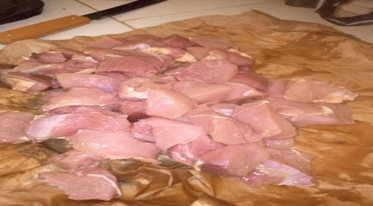
Plate 7: Fresh pieces of lean beef Plate 8: Finished danbutari product
C. Proximate Composition and pH of some Fresh and Stored Disappearing Meat Products in Kebbi State
Table 2 and Table 3 below shows the results of Proximate Composition and pH of some fresh and stored Disappearing Meat Products in Kebbi State, respectively. Result of fresh products indicated that there is significant differences (P<0.05) in respect to moisture content, Ash, protein, Nitrogen, and CHO of some disappearing meat product found in kebbi state and also shows no statistical differences from (P>0.05) Lipid and pH of some disappearing meat product found in kebbi state. Similarly, result of proximate composition after storage shows that storage had significantly affected (P<0.05) all proximate parameters measured. However, pH was not significantly affected by storage (P<0.05)
Table 2. Proximate Composition and pH of fresh disappearing meat products in Kebbi State
| Products | Proximate Properties | |||||
| Moisture (%) | Ash (%) | Lipid (%) | Protein (%) | CHO (%) | pH | |
| Danbutari | 60.5a | 8.3c | 10.5 | 23.2 b | 2.4 c | 7.0 |
| Gade | 5.0c | 18.0ab | 13.0 | 31.1 a | 24.0 a | 6.6 |
| Karmami | 11.3b | 18.6 a | 10.5 | 33.6 a | 16.3 b | 6.6 |
| Yawara | 3.0d | 16.6 b | 11.0 | 34.3 a | 25.0 a | 6.0 |
| SE | 0.44 | 0.43 | 0.59 | 0.90 | 1.47 | 0.24 |
abc= means with different superscripts along columns differ significantly (p<0.05)
Table 3. Proximate Composition and pH of stored processed disappearing meat products in Kebbi State
| Products | Proximate Properties | |||||
| Moisture (%) | Ash (%) | Lipid (%) | Protein (%) | CHO (%) | pH | |
| Gade | 6.83b | 15.67b | 9.00b | 49.47b | 9.67a | 6.0 |
| Karmami | 8.00a | 18.67a | 12.8a | 40.10c | 8.67ab | 6.0 |
| Yawara | 7.83a | 17.67 a | 3.0c | 63.37a | 3.47b | 6.0 |
| SE | 0.06 | 0.33 | 0.36 | 1.68 | 4.33 | 0.0 |
abc= means with different superscripts along columns differ significantly (p<0.05)
- Moisture content
From Table 2 it can be observed that danbutari product contained the highest (60.5%) moisture content followed by karmami product (11.3%), and then gade product (5.0%). The least in moisture content was yawara which recorded (3.0%). However, after storage of the three products (Table 3), the moisture content of the stored products were recorded as having 8.00, 7.83 and 6.83% for karrmami, yawara and gade, respectively. The reason why danbutari had the highest moisture content could not be unconnected to the fact that the product was an intermediate moisture meat while other products were dehydrated products. The moisture content of danbutari was found to be similar to other intermediate moisture meat reported by previous research. For instance 55.5% was recorded by Oladimeji et al. (2022) for chicken sausage, 45.00% reported by Unzil et al. (2021) for chicken burger, Jegede et al. (2018) recorded 51.28% and 61.59% for suya and asun respectively. Nady et al. (2021) also reported 62.15% for beef sausage. Ajai et al. (2018) recorded 32.51% for roasted beef. However the moisture of danbutari was lower than the values reported by Muhammad and Umar (2010) who reported 84.38% and 79.59% for tsire and balangu, respectively. The moisture content of the remaining dried products in the current study were found to be lower. This could obviously be as a result of the dehydration process the product were subjected to. By the nature of the products, they were intended for storage for future use, hence the lower moisture content. Similar values for dried meat products were reported in previous research such as Balarabe et al. (2018) who processed danbun nama from different meat types and recorded 9.9%, 6.44%, 2.8%, 10.6%, and 9.75% for beef, mutton, chevon, camel, and broiler chicken respectively. Similarly, Jegede et al. (2018) reported 4.97% for kundi, 9.75% was recorded for killishi by Idowu et al. (2010), Akinola et al. (2019) also recoeded 7.16 % for suya.
- Ash content
The ash content of the freshly produced products show that karmami constituted the highest value of (18.6%) followed by gade (18.0%), and then yawara and danbutari (16.6%) and (8.3%) respectively. Upon storage, the stored product recorded 18.67, 17.67 and 15.67% for karmami, yawara and gade respectively. This result however shows higher ash content when compared to previous research works on different intermediate moisture and dried meat products. For instance Unzil et al. (2021), Oladimeji et al. (2022), Nady et al. (2021), Ajai et al. (2018), Balarabe et al. (2018), Jegede et al. (2018), [11], [12], [13] and [14] all reported ash content values of between 0.41% to 8.78% for intermediate moisture and dried meat products in their works. However, [15] reported that ash content of dry meat products can be up to 12%. The Ash content values of current study were found to be up to 18%. This could probably be due to the degree of dryness of the products and type of meat used to prepare the products. The higher amounts of ash content signifies that the products will be high in minerals.
- Lipid content
The Lipid content of some freshly produced DMPs were statistically the same based on the result. However the Gade constituted the highest score of 13.0 (%) followed by yawara (11.0%), and then karmami and danbutari (10.5%) and (10.5%) respectively. For the stored products, karmami, gade and yawara recorded 12.8, 9.00 and 3.0%, respectively. These results were found to be similar to other intermediate moisture meat and dried meat products reported by previous research. For instance [16] recorded 23.42% and 15.15% for kundi and suya respectively, [17] recorded 8.75% for suya. 18.10% was recorded for killishi by [18], [12] also recorded 14.04 % for suya and [19] recorded 20.14% for chicken sausage.
- Protein content
The protein content of yawara, gade and karmami were found by the current research to be statistically the same. However, yawara constituted the highest score of (34.3%) followed by karmami (33.6%), and then gade (31.1%). The least in protein content was danbutari which recorded (23.2%) for fresh products. On the stored products, yawara, gade and karmami recorded 63.37%, 49.47% and 40.10%, respectively. The reason why yawara, karmami and gade had the higher protein content could not be unconnected to the fact that the products were dried meats while danbutari was an intermediate moisture meat product. It was reported by [20] that, the concentration of protein will be more in dry meat than intermediate moisture meat. Similar values of higher protein content for dried meat products were reported in previous research such as [21] recorded 58.0% for danbun nama, [16] reported 70.66% for kundi, 57.02% was recorded for killishi by [18], [13] recorded 60.33% and 59.41% for beef and pork killishi respectively. On the contrary, higher values for crude protein in dried meat samples were reported by [22] who recorded 92.75% and 92.21% for beef and broiler meat, although it was based on dry matter basis. However protein content of danbutari was found to be similar to other intermediate moisture meat reported by previous research. For instance [16] recorded 23.28% and 20.17% for suya and asun respectively.19.00% was recorded by [23] for chicken burger, [19] recorded 18.79% for chicken sausage, [24] reported 14.34% for beef sausage, [25] also recorded 36.66% for roasted beef and [[17] recorded 17.30% for suya.
- Carbohydrate (CHO) content
The CHO content of yawara and gade are statistically the same, but Yawara constituted the highest score of (25.0%)) followed by gade (24.0%), and then karmami (16.3%). The least in CHO content was danbutari which recorded (2.4%) for fresh products. for the stored products, gade, karmami and yawara recorded 9.67%, 8.67% and 3.4%, respectively. This results was found to be similar to other intermediate moisture meat and dried meat products reported by previous research. For instance [23] recorded 18.55% for chicken burger, [25] recorded 19.34% for roasted beef,[24] reported 5.00% for beef sausage, [17] recorded 2.45% for suya.
- pH content
The pH content of some DMPs are statistically the same based on the result. However the Danbutari constituted the highest score of (7.0%) followed by Gade (6.6%) and karmami (6.6%) then yawara (6.0%) having the pH value for fresh products. The stored products recorded 6.0 each suggesting that the products were slightly acidic. This condition could make the product to be unfavorable for microbial growth, hence, increasing its safety and shelf life. This result was found to be nearly similar to [26] which recorded 9.07% pH content for suya.
D. Sensory Properties of some Disappearing Meat Products in Kebbi State
Table 4 below shows the results of Sensory Properties of some Disappearing Meat Products in Kebbi State. Result indicated that, the panelist sensory judgment established significant differences (P<0.05) on juiciness and flavor while aroma and tenderness shows no significant differences (P>0.05) across the DMPs. However, all the panelists agreed that the products exhibited the good sensory qualities of tenderness, juiciness, flavor and aroma because all the scores fall between of 5.5 and 8.7 on a 9 point hedonic scale, with the acceptable limits of 5.5. with regards to total score, danbutari, gade, yawara and karmami were ranked 1st, 2nd, 3rd and 4th, respectively.
Table 4. Sensory properties of some disappearing meat products in Kebbi State.
| Products | Sensory parameters | Total | Rank | |||
| Tenderness | Juiciness | Flavor | Aroma | |||
| Danbutari | 7.7 | 8.0a | 8.7a | 8.0 | 8.1 | 1st |
| Gade | 7.4 | 7.6a | 7.8ab | 7.8 | 7.65 | 2nd |
| Karmami | 6.1 | 5.8b | 6.5c | 7.4 | 6.45 | 4th |
| Yawara | 5.5 | 7.4ab | 7.1bc | 7.0 | 6.75 | 3rd |
| SE | 0.67 | 0.45 | 0.31 | 0.54 | ||
abc= means with different superscripts along columns differ significantly (p<0.05)
From Table 4, it can be observed that danbutari had the total highest score in all the quality parameters evaluated. In Juiciness, danbutari and gade were statistically similar with scores of 8.0 and 7.6, respectively. Since juiciness is the amount of water retained by a product, danbutari and gade had higher moisture content than other products. Danbutari being an intermediate moisture meat prepared directly from fresh beef and gade which is a relatively karge chunk of dried meat is able to absorb enough moisture because of its surface area and microfibrils. Similarly, flavor values shows that danbutari had the highest score on juiciness 8.7 followed by gade, yawara and karmami which have 7.8, 7.1 and 6.5 respectively. The results of the current research were found to be similar with previous research works. For instance on juiciness [27] recorded 7.45 for fried beef, [21] recorded 7.37 for danbun nama and [28] recorded 8.7 for processed non ruminant meat. On flavor this results was found to be similar with [27] recorded 7.50 for fried beef and [28] recorded 8.5 for processed non ruminant meat. On tenderness this results was found to be similar with [21] recorded 7.45 for danbun nama [27] recorded 6.85 for fried beef and [28] recorded 8.6 for processed non ruminant meat. While on aroma this research was found to be similar with the previous research of [21] which recorded 7.39 for danbun nama and [28]which recorded 7.95 for fried beef.
E. T-test Analysis for Fresh and Stored Proximate Composition and pH of Some Disappearing Meat Products in Kebbi State
Results for t-test of proximate composition of DMPs before and after storage are presented in Table 5. Results showed that storage had highly significantly affected (P<0.01) total Protein, total carbohydrate contents and total pH of fresh and stored DMPs with total P-values of 9.30E-05, 1.70E-06, and 0.046, respectively. However, storage had not significantly affected (P<0.05) moisture, ash and lipid contents of the product. From the results, individual products shows different dynamics as far as effect of storage on their various proximate components are concerned.
The moisture content of karmami with a p-value of 0.01 significantly dropped from 11.33% in fresh samples to 8.0% in stored samples. This could be as a result of the nature of the product which is a sliced dried meat which makes it easier for escape of moisture. However, in yawara and gade, the moisture content have significantly increased at storage. This might not be unconnected with the thickness of the products which might retain moisture and can be able to absorb atmospheric moisture. [29] reported that moisture can enter into a product in a number of ways, it could be related to the production method of the product, the atmospheric moisture in the food production area, the packaging’s to get method of the product, or it can be related to the method of food storage. The lipid content of the stored products were observed to have dropped from the fresh products. This could not be unconnected with the continuous loss of fats due to drying, protein-lipid co-oxidation and other chemical changes lipids under storage as reported by [30] that protein co-oxidation is strongly interlinked with lipid oxidation in meat-based RTE products because lipid and protein are closely associated in food structures and in membranes. Indeed, most intermediate and final products from lipid oxidation would react with protein and that protein co-oxidation with lipid in meat-based RTE products is complicated because the progress of lipid-protein co-oxidative degradation in low moisture foods has been relatively slow (which takes months to years) compared to high moisture foods. The protein content have significantly increased across all the products at storage.
Table 5. T-test analysis for fresh and stored proximate composition and pH of some disappearing meat products in Kebbi State
| Parameter | Status | Total | P-value | Karmami | Pvalue | Gade | P-value | Yawara | P-value |
| Moisture | Fresh | 6.44 | 0.402ns | 11.33 | 0.01** | 5.00 | 0.006** | 3.00 | 0.0001** |
| Stored | 7.55 | 8.00 | 6.83 | 7.83 | |||||
| Ash | Fresh | 18.05 | 0.421ns | 19.00 | 1.00ns | 18.33 | 0.002** | 16.83 | 0.101ns |
| Stored | 17.55 | 19.00 | 15.83 | 17.83 | |||||
| Lipid | Fresh | 11.5 | 0.051ns | 10.50 | 0.011* | 13.00 | 0.002** | 11.00 | 0.001** |
| Stored | 8.27 | 12.83 | 9.00 | 3.00 | |||||
| Protein | Fresh | 33.02 | 9.30E-05** | 33.63 | 0.01** | 31.13 | 0.000006** | 34.30 | 0.000006** |
| Stored | 50.97 | 40.10 | 49.47 | 63.37 | |||||
| CHO | Fresh | 22.15 | 1.70E-06** | 16.57 | 000044* | 24.37 | 0.000006** | 25.53 | 0.000007** |
| Stored | 7.41 | 8.90 | 9.87 | 3.47 | |||||
| pH | Fresh | 6.79 | 0.046* | 7.00 | 0.74ns | 6.98 | 0.002** | 6.39 | 0.09ns |
| Stored | 6.55 | 6.41 | 6.62 | 6.62 |
**Highly significant (P<0.01)
*significant (P<0.05)
ns= not significant
CHO= carbohydrates
CONCLUSION
In conclusion, the findings of the study had proven that there are ethnic meat products in the study area that have disappeared or on the verge of disappearing by identifying 16 of such products across the state. The production process of such products were harmonized and described for future reference. It was also found out that the products have high nutritive value with the fresh products recording crude protein ranging 23.2 – 34.3% and stored products recording even higher crude protein of 40.10 – 63.37%. Similarly, the products were found to exhibit positive sensory properties by recording 5.5 to 8.7 on a 9 point hedonic scale, with the acceptable limits of 5.5 on all the sensory indices measured. Merit analysis indicated that Karmami performed better among the dried DMPs ranking 1st in optimizing proximate and eating qualities.
REFERENCES
- Nico, C.M. (2018). Our traditional food and street foods are disappearing. https://www.linkedin.com
- Azad, S A K, Naga Mallika, E, Bhaskar Reddy, G V and Naveen Kumar, G (2016). Ethnic methodology of preparation of low fat meat products in North Coastal Andhra Pradesh. Indian Journal of Traditional Knowledge, 15(2): 285-291.
- UNESCO (2022) Summary Cultural heritage: 7 successes of UNESCO’s preservation work.
- Sudhakar, B. and Yogesh, G. (2022). Ethnic meat products/Indian subcontinent. Reference Module in Food Science.
- Renuka Nayar, Kavitha Rajagopal, Solomon Rajkumar and Magna Thomas. 2021. Documentation and Evaluation of Traditional Meat Products of North Malabar. Int.J.Curr.Microbiol.App.Sci. 10(01): 1184-1194.
- Laranjo, M., Talon, R., Laukova, A., Fraqueza, M.J and Elias, M. 2017. Traditional meat products: improvement of quality and safety. Journal of Food Quality: p. 2.
- Gwin, Lauren, Arion Thiboumery, and Richard Stillman (2013). Local Meat and Poultry Processing: The Importance of Business Commitments for Long-Term Viability, ERR-150, U.S. Department of Agriculture, Economic Research Service, June 2013
- Suthon, S (2020). Disappearing dishes. Bangkok post online news. Retrieved from https://www.bangkokopost.cm/life/social-and-lifestyle/1942100/disappearing-dishes
- Kebbi state (2018) About Kebbi State | The Official Website of Kebbi State Governmenthttps://www.kebbistate.gov.ng/about-kebbi-state
- AOAC (2011). Official Methods of Analytical Chemists. Association of Official Analytical Chemists International, Gaithersburg.
- Idowu, A.O., t. O. Omobuwajo and k. O. Falade (2010) production proximate analysis and shelf life studies of ready-to-eat rice and kilishi african journal of food science vol 4. (5):264- 268.
- Akinola,t.o fatummibi, o.o alakeo.t. Asagbra a.e and onawolao.o (2019). Proximate and mineral composition of locally sourced suya spices sold in agege area of lagos state. World journal of innovative research (wjir) volume-6, issue-4, april 2019 pages 49-54
- Ogunsola, O.O. and a. B. Omojola (2008) qualitative evaluation of kilishi prepared from beef and Pork african journal of biotechnology academic journals, meat science laboratory, department of animal science, university of ibadan, ibadan nigeria. 7 (11), pp. 1753-1758.
- Adeniyi, OR., A. A. Ademosun and o. M. Alabi (2011) proximate composition and economic values of four common sources of animal protein in south-western nigeria zootecnia trop., 29(2): 231-234. 2011
- Jegede, o. B., ogunwole, o. A. And omojola, a. B. (2018) quality attributes and safety of processed meat products in ibadan, nigeria nigerian journal of animal production nigerian society for animal production nig. J. Anim. Prod. 2018, 45(4):210 – 221.
- Albert O. Fasogbon, Joseph O. Odewade, Lydia O. Odewade(2021)Proximate Analysis and Mycological Assessment of Suya Sold in Kabuga, Kano State, Equity Journal of Science and Technology, An Official Publication of Kebbi State University of Science and Technology, Aliero, Nigeria 8(1): 49 – 53.
- Oladimeji S. T., Azeez, A. A., Ezenwogene, R. C., Onatola, I. T., Ugama, E. E., Ate, J. T. and 1Ajekiigbe, D.A. (2022) Analysis of the Proximate Composition and Microbial Load of Chicken as Influenced by Oven. Nigerian Journal of Agricultural Economics (NJAEC). Volume 10(1), 2020: Pages 40-50
- Mediani A, Hamezah HS, Jam FA, Mahadi NF, Chan SXY, Rohani ER, Che Lah NH, Azlan UK, Khairul Annuar NA, Azman NAF, Bunawan H, Sarian MN, Kamal N and Abas F (2022) A comprehensive review of drying meat products and the associated effects and changes. Front. Nutr. 9:1057366.
- Balarabe, S. Doma, U. D. and Kalla, D. J. U. (2018) Effects of chemical composition and type of panelists on sensory properties of fried minced meat (Dambun nama) processed from red and white meat Nigerian Anim. Sci. 2018, 20 (1): 220-228.
- Unzil, n. a, azlan a. And sultana s (2021) proximate composition analysis of chicken burgers from night market stalls and selected fast-food restaurants food research 5 (1): 471 – 477
- Nady Khairy, Mohamed Karmi, Mohamed Abdelfattah Maky (2021) Proximate Composition Analysis of Beef Sausage, Aswan University Journal of Environmental Studies (AUJES) 2, No. 3, pp. 155-161.
- Ajai, A.I., A. Inobeme, N. Nwakife and N. A. Abubakar (2019). Proximate and essential mineral composition of fresh and smoked catfish and beef sold in minna, niger state.
- Edema, Mojisola Olayinka, Osho Adetokunbo Temitope and Diala Chukwunonye Innocent (2008) Evaluation of microbial hazards associated with the processing of Suya (a grilled meat product) Scientific Research and Essay, Academic Journals Vol. 3 (12), pp. 621-626.
- Abubakar, S., Ribah, M. I. and Muftau, M. A. (2021) Effect of Some Natural Additives and Forms of Application on Organoleptic Properties of Fried Beef International Journal of Food Nutrition and Safety, 2021, 12(1): 41-46.
- Abubakar, M. M., Bube, M. M., Adegbola, T. A. and Oyawoye, E. O. (2011) Processing and evaluation of dambu, tsire and balangu from non-ruminant animals Animal Production Programme, Abubakar Tafawa Balewa University, Bauchi, Nigeria.
- Moore, Sarah. (2020). Why is Moisture Content Analysis of Food Important? News-Medical. Retrieved on October 14, 2023from https://www.news-medical.net/life-sciences/Why-is-Moisture-Content-Analysis-of-Food-Important.aspx.
- Hazrati W., Shyan Y. C., Mohammad Z., Farah S.H, Nor A. M., Wan Z. W. and Nazamid S. (2019). Effects of Storage Time and Temperature on Lipid Oxidation and Protein Co-Oxidation of Low-Moisture Shredded Meat Products. Antioxidants, 8:486


